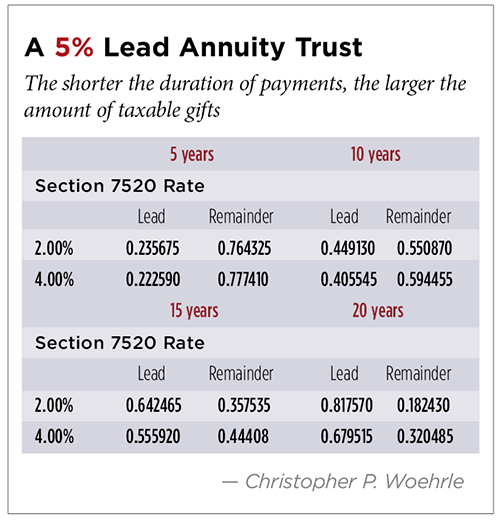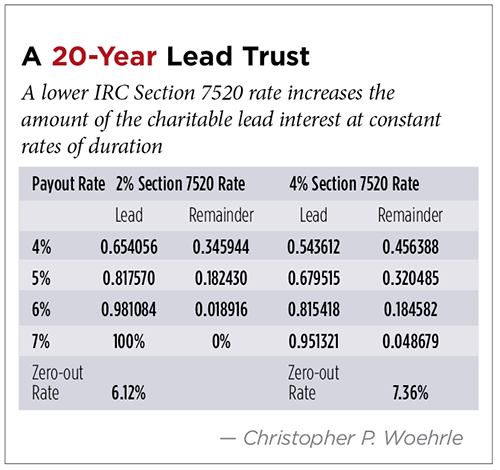The inflation adjustment of the unified gift and estate tax exemption to $5.43 million, coupled with a low interest rate environment, opens the door to yet another year for creating a qualified charitable lead trust (CLT) to transfer wealth to family and charities. For existing CLTs, the continued strong performance of the capital markets should compel trustees to evaluate the usefulness of commuting the charitable interest. Not only do CLTs continue meriting serious consideration, but also there may be planning opportunities for nonqualified CLTs benefiting non-lineal heirs, especially for owners of highly appreciating assets generating no immediate or small income.
Opportunities With Qualified CLTs
The qualified CLT offers philanthropic clients a way to do good and transfer assets to family members with reduced transfer tax cost. In designing a qualified CLT, the planning goal is to zero-out so that there’s no taxable gift to the remaindermen. Because the gift and estate exemption is near historic highs, a donor may be willing to incur a taxable gift to the remaindermen. The amount of the taxable gift likely generates no immediate gift tax but will draw down the exemption.
The payment to the charity must be expressed as a fixed percentage of the initial amount of trust (annuity amount) or as a fixed percentage of its annual value (unitrust amount).1 The duration of the payments may be for a fixed term of years or permitted measuring lives.2 The amount of the taxable gift from the remainder interest is determined by a combination of the duration and amount of the charitable payments, as well as the Internal Revenue Code Section 7520 rate.3 (See “A 5% Lead Annuity Trust,” this page, illustrating that the shorter the duration of payments, the larger the amount of the taxable gift at constant IRC Sec- tion 7520 rates, and “A 20-Year Lead Trust,” this page, illustrating how a lower Section 7520 rate increases the amount of the charitable lead interest at constant rates of duration.)

Opportunities With Qualified CLTs
Sometimes, the investment performance of a CLT exceeds original projections. Perhaps an acquisition of an invested asset in a tax-free reorganization creates a windfall gain. The trustee is faced with the issue of whether it’s possible to prepay the charitable interest. The charity and noncharitable remaindermen are almost certain to consent to the trustee’s request, as each beneficiary receives its interest sooner. After waging losing battles against commutation, the IRS has ruled that prepayment of a charitable lead annuity trust (CLAT) is allowed if the trustee didn’t have the discretion to prepay, and the amount paid is the undiscounted future amount.4 The IRS continues to rule against prepayment of charitable lead unitrusts (CLUTs), reflecting its concern about the trustee arbitraging the difference between Section 7520 interest rates at the time of creation and commutation of the CLT.5 The prepayment of the charity’s interest doesn’t entitle the trust to a charitable deduction.6
Opportunities With Nonqualified CLTs
Income tax consequences. A nonqualifying non- grantor CLT provides for payment of the net income from the trust. Because the payment to the charitable beneficiaries is neither a unitrust nor annuity trust amount, the trust isn’t qualified.7 The donor to the charitable income trust receives neither an income tax nor a transfer tax deduction. Notwithstanding these tax disincentives, such a nonqualified trust has a powerful income tax-related advantage. Because the nonqualifying CLT can be non-grantor for federal income tax purposes, the donor isn’t taxed on the income earned from it. The net effect to the donor is as if he received a full charitable deduction, even if he previously exceeded his adjusted gross income (AGI) limits. That could be the case if the donor has contributed cash or appreciated property to a private foundation whose limits are respectively 30 percent and 20 percent of AGI.
Its other advantage arises from the flexibility in the choice of funding asset. The ability to fund a CLT with a highly appreciated asset with additional growth potential but insufficient income is possible. Because the charitable income trust isn’t required to pay out an annuity or unitrust amount, the trust isn’t compelled to sell all or a portion of such an asset.
Example: Sally, age 55, hasn’t yet consumed her lifetime gift exemption through a series of gifts to nieces and nephews. The local hospital recently solicited her for a lead gift to its capital campaign. Sally is unsure whether she has the optimal assets to fund a CLT. She does own a very valuable undeveloped parcel of land purchased for $100,000 and now appraised at $1 million. Presently, the property doesn’t generate income, though it has rental income capabilities.
The income earned from the rents is projected to be 4 percent of the property’s current appraised value. A conventional CLUT or CLAT would necessitate sale of the land and any subsequently built rental properties to meet the zero-out rate of 6.12 percent assuming a 20-year term. (See “A 20-Year Lead Trust,” p. 9.) She decides to fund a non-grantor charitable lead income trust with the land. The remainder interest passes to her nieces and nephews in 20 years. While Sally doesn’t receive an income tax deduction, she won’t be taxed on any future rents from any subsequently built income properties.8 Sally’s remaining unified exemption is sufficient to eliminate payment of a gift tax on the remainder interest of $345,944.9 If Sally survives the 20-year term, the appreciation of the land and rental building passes transfer tax free to her family. Sally will also have supported her favorite charity.

The transfer tax consequences of a charitable lead income trust must be scrutinized for those donors who are likely to be subject to the federal estate tax.
Estate and gift tax consequences. Because the charitable lead income trust is nonqualified, there’s no gift or estate tax deduction for the charitable interest at the time of funding. To avoid consuming the unified exemption, the donor should retain the power to determine annually the charitable beneficiary. Doing so prevents the completion of the gift at the time of transfer. To avoid inclusion in the gross estate of the date-of-death value, the donor must survive the term of the charitable lead income trust.
Because the charitable lead income trust is likely to be funded with illiquid assets, it’s critical that the charitable income beneficiary still have a “degree of beneficial enjoyment” within the meaning of the regulations under Section 7520.
Appeal of Lead Trusts
Even a doubling of the Section 7520 rate from 2 percent to 4 percent in the near future won’t dramatically diminish the utility of qualified CLTs. While Congress can always reduce the gift and estate exemption as part of a revenue-raising bill or even a revenue-neutral tax reform, CLTs remain attractive. The nonqualified, non-grantor charitable income trust merits study to benefit heirs, such as nieces and nephews who aren’t family members within the meaning of IRC Section 2702(c)(2). A private letter ruling would be recommended to determine whether Section 2702(c)(2) was intended to cover gifts to children and grandchildren. If determined not to be applicable, a charitable lead income trust will be even more useful.
Endnotes
1. Internal Revenue Code Sections 170(f)(2)(B), 2055(e)(2)(B) and 2522(c)(2)(B).
2. Treasury Regulations Sections 1.170A-6(c)(2)(i)(A),1.170A-6(c)(2)(ii)(A), 20.2055-2(e)(2)(vi)(a), 20.2055-2(e)(2)(vii)(a), 25.2522(c)-3(c)(2)(vi)(a), 25.2522(c)(2)(vii)(a).
3. IRC Section 7520.
4. Revenue Ruling 88-27, cited in Private Letter Ruling 9734057 (May 28, 1997).
5. See General Counsel Memoranda 39676 in its discussion of “Issue (1).”
6. IRC Section 170(f)(2)(B).
7. See supra note 1.
8. Treas. Regs. Section 25.7520-3(b)(2)(ii) and Ex. (1) and (2) from Treas. Regs. Section 25.7520-3(b)(2)(v).
9. See “A 20-Year Lead Trust,” p. 9, noting that the zeroed-out rate increase from 6.12 percent to 7.36 percent on a doubling of the Section 7520 rate from 2 percent to 4 percent.





